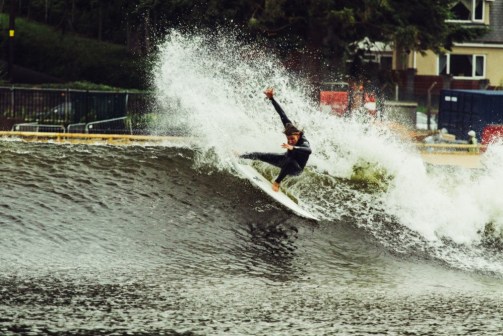
12 Nov Bringing the Beach Inland: Artificial Wave Pools and Competitive Surfing
Since the announcement of surfing’s potential inclusion in the 2020 Tokyo Olympic Games, the question has been asked and answered with starkly opposing viewpoints from surfers and enthusiasts all over the world:
Should surfing be included in the Olympics?
The question is still being widely debated—largely amongst those who will ultimately have no say in the matter—as we await the final decision of the International Olympics Committee. The idea of including surfing in the Olympics inevitably has its pros and cons for fans of the sport, but the undeniably positive advancement being made, regardless of the Committee’s decision, is in the technology needed to make surfing’s inclusion a reality: Wave pools.
For better or for worse, competitive surfing has always been at the mercy of natural weather, tide, and swell conditions during competitions. For surfing to be included in the Olympics, regulatory technology was needed in order to make each set of waves a consistent, equal opportunity to perform for each competitor; whether this premise aligns with or diminishes the best parts of surfing is what debaters tend to disagree over. The artificial wave pools that have begun cropping up worldwide (like Wavegarden’s Surf Snowdonia in North Wales, featured above) can theoretically eliminate these external factors entirely by constructing identical sets of waves for each competing surfer from scratch.
Late last year, Red Bull hosted the world’s first surfing competition held in an artificial wave pool at Surf Snowdonia (called Red Bull Unleashed), giving us a preview of what the sport might look like in the Olympics, shown in the video above. According to GrindTV, “As opposed to a traditional surf contest with typical 30-minute, best-two-waves heats, Red Bull Unleashed offered two dueling surfers five identical waves. The surfer who won the best of five series advanced to the next round.” Those involved in the competition were generally pleased with the opportunities the Wavegarden produced, and Red Bull noted in their press release that “Surf Snowdonia’s lagoon offer[ed] the ideal blank canvas for surfers to express themselves.”

Amidst all of the excitement surrounding its opening however, the Surf Snowdonia Wavegarden has been closed twice now since its opening last year due to mechanical and technical malfunctions. The second closure was originally intended to span only two days but quickly became an indefinite project, raising concern about the reliability and functionality of commercial wave pools for competitions.

Repairs evidently look promising, though, as Surf Snowdonia has since removed the uncertain terminology pictured above from their webpage. The site now reports that booking options will be available soon for the April 2016 season– at which time Wavegarden’s newest project in Austin, TX is set to open. Texans, get excited: this new U.S. pool will feature “perfect ocean-like waves suitable for surfers of all levels, ranging between one to six feet high, with a lengthy surfing experience of 35 seconds per wave… [and will be] located on a rural property the size of nine football fields.”
Whether you’re a proponent of artificial wave competition in the Olympics or not, the influence that commercial wave pools will undoubtedly have on the sport is not limited to competitive surfing or its inclusion in the Olympics. Surfing’s addition to the 2020 Tokyo Games in combination with the rising number of inland opportunities to surf in Wavegardens and similar facilities could mean a serious uptick in the sport’s popularity. Some speculate that it could even change the dynamic of surfing as we know it– but for now, we wait and enjoy the ocean’s natural waves, as we always have.




Sorry, the comment form is closed at this time.